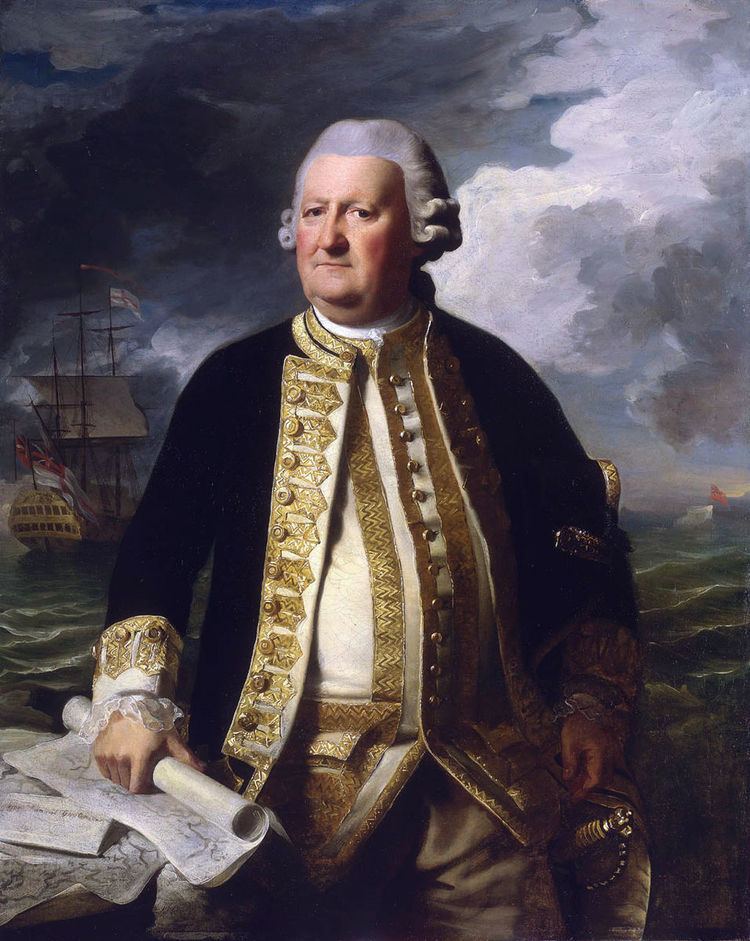Name Clark Gayton Service/branch Royal Navy | Role Royal Navy officer Rank Admiral | |
 | ||
Commands held Bien AimeMermaidAntelopeRoyal AnnePrinceSt GeorgeSan AntonioJamaica Station Battles and wars | ||
Admiral Clark Gayton (1712 - 5 March 1785) was an Admiral in the British Royal Navy serving in the American Revolutionary War and in the West Indies before retiring to his home in Fareham, England. His brother George Gayton was also in the Navy and achieved the rank of Vice-Admiral. He was born in Portsmouth, England, the third son of John Gayton who was postmaster of Portsmouth and Eleanor Clark. He was christened in St Thomas' Church, Portsmouth, Hampshire on 18 April 1712. Clark Gayton also had five other siblings: Mary Gayton (b. 1706), Jane Gayton (b. 1707), Thomas Gayton (b. 1713), John Gayton (b. 1714), and Henry Rouss Gayton (b. 1717).
Contents
Navy career
He served as Midshipman to Captain Peter Warren aboard the Squirrel off the coast of North America when he was in his twenties and thereafter in the West Indies under Commodore Knowles who promoted him to command the storeship Bien Aime on 12 August 1744.
He was based in Boston in July 1745 again under Commodore Peter Warren when he was placed in command of the Mermaid and also in charge of a convoy returning to England in March 1746. He remained in command of the Mermaid based in Portsmouth until September 1747.
We was then without a ship and on half pay until he was given the command of and commissioned the Antelope in May 1756, transferring to the Royal Anne guardship based in Spithead in August of the same year. Six months later he served as Flag-Captain under Admiral Henry Osborn in command of the Prince. In 1758 he was appointed to the St George and it was in command of this vessel that he departed for the West Indies joining the squadron under the command of Commodore Moore. Engagements at this time included the failed attack on Martinique and the invasion of Guadeloupe in 1758/1759.
The St George returned to Europe at the end of 1759 and remained there attached to the Grand Fleet in the Bay of Biscay until the declaration of peace.
From 1769 Gayton commanded the guardship San Antonio at Portsmouth. He was promoted to Rear-Admiral in October 1770 and left England four years later with his flag on the Antelope to take command of the Jamaica Station where he met a young Horatio Nelson, then Lieutenant Nelson when he served as Lieutenant aboard the Lowestoffe. Gayton had many difficulties with the French officials that were his counterparts in Cap Francais as well as the French governor concerning movements of his forces in the conduct of their duties. He was promoted to the rank of Vice-Admiral in February 1776. During his time as commander of Jamaica station more than 235 vessels were seized. He returned to England in April 1778 after which he had no further service. He gained the rank of Admiral in April 1782. He was succeeded by Sir Peter Parker as commander of Jamaica station.
His health was very poor in his last years and he died in Fareham on 5 March 1785 aged 74.
The National Maritime Museum has his portrait by John Singleton Copley painted about 1785.
Marriage and family
When stationed in Boston he married a colonist and citizen of Boston, Judith Rawlins (10 October 1714 - aft 1751, daughter of Captain John Rawlins (shipmaster) and Love Prout) by whom he had one son George Clark Gayton (1751-1800) and after her death, Elizabeth Legge. She remarried four months after his death to Thomas Newsham.
Clark Gayton's father; John Gayton (1682-1737) was the late Postmaster of Portsmouth. Thomas Gayton was the grandfather of Clark Gayton and was a Gentleman of Portsmouth who died in 1694, before his death he married a woman by the name of Jane. From the will that Thomas Gayton left he says: 'i give a guinea to each of my seven children' - the only children of Thomas Gayton that have been found so far are John Gayton (the admiral's father) and Joanna Gayton (b.1680) the sister of John and aunt of Clark Gayton and his siblings.
